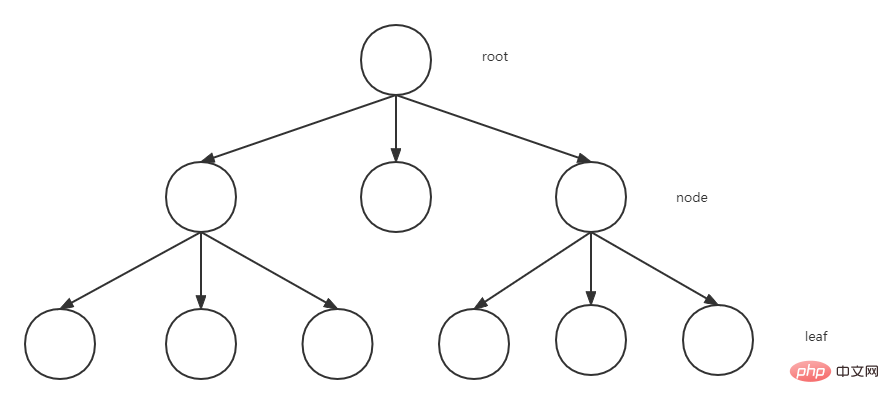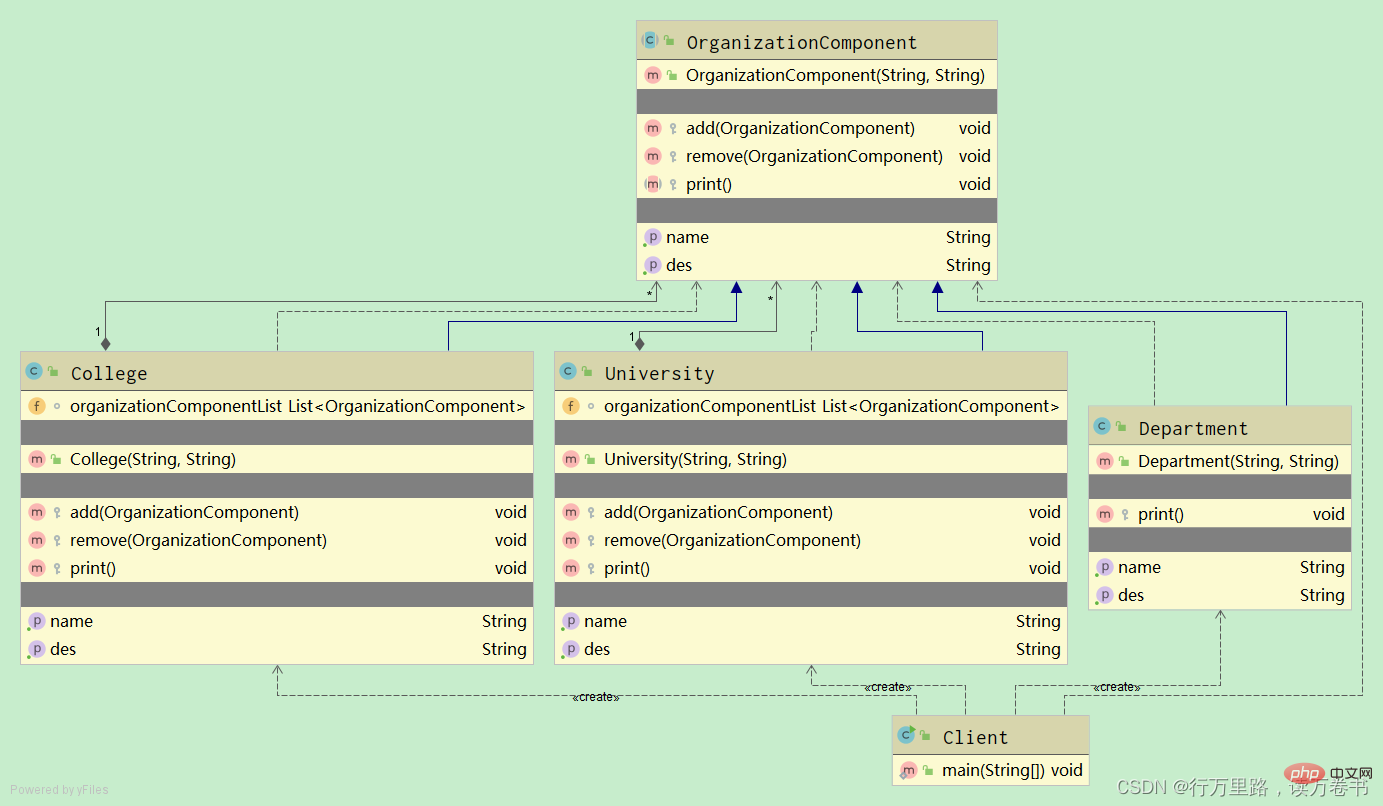Java設計模式之組合模式實例分析
1.基本介紹
1)組合模式(Composite Pattern),又叫部分整體模式,它創建了對象組的樹形結構,將對象組合成樹狀結構以表示“整體-部分」的層次關係
2)組合模式依據樹狀結構來組合對象,用來表示部分以及整體層次
3)這種類型的設計模式屬於結構型模式
4)組合模式使得使用者對單一物件和組合物件的存取具有一致性,即:組合能讓客戶以一致的方式處理個別物件以及組合物件
2.結構
#組合模式主要包含三種角色:
抽像根節點(Component):定義系統各層次物件的共有方法與屬性,可以預先定義一些預設行為與屬性
樹枝節點(Composite):定義樹枝節點的行為,儲存子節點,組合樹枝節點和葉子節點形成一個樹狀結構
葉子節點(Leaf):葉子節點對象,其下再無分支,是系統層次遍歷的最小單位
3.組合模式解決的問題
1)組合模式解決這樣的問題,當我們要處理的物件可以產生一顆樹狀結構,而我們要對樹上的節點和葉子進行操作時,它能夠提供一致的方式,而不用考慮它是節點還是葉子
2)對應的示意圖

4.組合模式解決學校系展示
1)應用實例要求
編寫程式展示一個學校系所結構:需求是這樣的,要在一個頁面中展示出學校的系組成,一個學校有多個學院,一個學院有多個系
2)思路分析與圖解(類別圖)

3)程式碼實作
Component組合物件宣告介面
package com.zte;
public abstract class OrganizationComponent {
private String name;// 名字
private String des;// 说明
public String getName() {
return name;
}
public String getDes() {
return des;
}
protected void add(OrganizationComponent organizationComponent) {
// 默认实现
throw new UnsupportedOperationException();
}
protected void remove(OrganizationComponent organizationComponent) {
// 默认实现
throw new UnsupportedOperationException();
}
// 构造器
public OrganizationComponent(String name, String des) {
this.name = name;
this.des = des;
}
// 方法print,抽象方法
protected abstract void print();
}Composite非葉子節點
package com.zte;
import java.util.ArrayList;
import java.util.List;
// University 就是 Composite,可以管理College
public class University extends OrganizationComponent {
List<OrganizationComponent> organizationComponentList = new ArrayList<>();
// 构造器
public University(String name, String des) {
super(name, des);
}
//重写add
@Override
protected void add(OrganizationComponent organizationComponent) {
organizationComponentList.add(organizationComponent);
}
// 重写remove
@Override
protected void remove(OrganizationComponent organizationComponent) {
organizationComponent.remove(organizationComponent);
}
@Override
protected void print() {
System.out.println("==========" + getName() + "=========");
for (OrganizationComponent organizationComponent : organizationComponentList) {
organizationComponent.print();
}
}
@Override
public String getName() {
return super.getName();
}
@Override
public String getDes() {
return super.getDes();
}
}Composite非葉子節點
package com.zte;
import java.util.ArrayList;
import java.util.List;
public class College extends OrganizationComponent {
// list中存放department
List<OrganizationComponent> organizationComponentList = new ArrayList<>();
public College(String name, String des) {
super(name, des);
}
//重写add
@Override
protected void add(OrganizationComponent organizationComponent) {
organizationComponentList.add(organizationComponent);
}
// 重写remove
@Override
protected void remove(OrganizationComponent organizationComponent) {
organizationComponent.remove(organizationComponent);
}
@Override
protected void print() {
System.out.println("==========" + getName() + "=========");
for (OrganizationComponent organizationComponent : organizationComponentList) {
organizationComponent.print();
}
}
@Override
public String getName() {
return super.getName();
}
@Override
public String getDes() {
return super.getDes();
}
}Leaf葉子節點
package com.zte;
public class Department extends OrganizationComponent {
public Department(String name, String des) {
super(name, des);
}
// add和remove方法就不需要再写了
@Override
protected void print() {
System.out.println("===========" + getName() + "=========");
}
@Override
public String getName() {
return super.getName();
}
@Override
public String getDes() {
return super.getDes();
}
}package com.zte;
public class Client {
public static void main(String[] args) {
// 创建大学
OrganizationComponent university = new University("清华大学", "中国最好的大学");
// 创建学院
OrganizationComponent college1 = new College("计算机学院", "计算机学院");
OrganizationComponent college2 = new College("信息工程学院", "信息工程学院");
// 创建各个学院下面的系
college1.add(new Department("软件工程", "软件工程"));
college1.add(new Department("网络工程", "网络工程"));
college1.add(new Department("计算机科学与技术", "老牌专业"));
college2.add(new Department("通信工程", "通信工程"));
college2.add(new Department("信息工程", "信息工程"));
// 将学院添加到学校中
university.add(college1);
university.add(college2);
// 打印大学底下的所有院系
university.print();
// 打印学院底下的所有系
college1.print();
}
}5.組合模式的注意事項和細節
1)簡化客戶端操作,客戶端只需要面對一致的物件而不用考慮整體部分或節點葉子的問題
2)其有較強的擴展性,當我們需要修改組合物件時,我們只需要調整內部的層次關係,客戶端不用做出任何改動
3)方便創建出複雜的層次結構,客戶端不用理會組合裡面的組成細節,容易添加節點或者葉子從而創建出複雜的樹形結構
4)需要遍歷組織機構,或處理的物件具有樹狀結構時,非常適合使用組合模式
5)要求較高的抽象性,如果節點和葉子有很多差異性的話,例如很多方法和屬性都不一樣,不適合使用組合模式
以上是Java設計模式之組合模式實例分析的詳細內容。更多資訊請關注PHP中文網其他相關文章!

熱AI工具

Undresser.AI Undress
人工智慧驅動的應用程序,用於創建逼真的裸體照片

AI Clothes Remover
用於從照片中去除衣服的線上人工智慧工具。

Undress AI Tool
免費脫衣圖片

Clothoff.io
AI脫衣器

Video Face Swap
使用我們完全免費的人工智慧換臉工具,輕鬆在任何影片中換臉!

熱門文章

熱工具

記事本++7.3.1
好用且免費的程式碼編輯器

SublimeText3漢化版
中文版,非常好用

禪工作室 13.0.1
強大的PHP整合開發環境

Dreamweaver CS6
視覺化網頁開發工具

SublimeText3 Mac版
神級程式碼編輯軟體(SublimeText3)
 突破或從Java 8流返回?
Feb 07, 2025 pm 12:09 PM
突破或從Java 8流返回?
Feb 07, 2025 pm 12:09 PM
Java 8引入了Stream API,提供了一種強大且表達力豐富的處理數據集合的方式。然而,使用Stream時,一個常見問題是:如何從forEach操作中中斷或返回? 傳統循環允許提前中斷或返回,但Stream的forEach方法並不直接支持這種方式。本文將解釋原因,並探討在Stream處理系統中實現提前終止的替代方法。 延伸閱讀: Java Stream API改進 理解Stream forEach forEach方法是一個終端操作,它對Stream中的每個元素執行一個操作。它的設計意圖是處
 PHP:網絡開發的關鍵語言
Apr 13, 2025 am 12:08 AM
PHP:網絡開發的關鍵語言
Apr 13, 2025 am 12:08 AM
PHP是一種廣泛應用於服務器端的腳本語言,特別適合web開發。 1.PHP可以嵌入HTML,處理HTTP請求和響應,支持多種數據庫。 2.PHP用於生成動態網頁內容,處理表單數據,訪問數據庫等,具有強大的社區支持和開源資源。 3.PHP是解釋型語言,執行過程包括詞法分析、語法分析、編譯和執行。 4.PHP可以與MySQL結合用於用戶註冊系統等高級應用。 5.調試PHP時,可使用error_reporting()和var_dump()等函數。 6.優化PHP代碼可通過緩存機制、優化數據庫查詢和使用內置函數。 7
 PHP與Python:了解差異
Apr 11, 2025 am 12:15 AM
PHP與Python:了解差異
Apr 11, 2025 am 12:15 AM
PHP和Python各有優勢,選擇應基於項目需求。 1.PHP適合web開發,語法簡單,執行效率高。 2.Python適用於數據科學和機器學習,語法簡潔,庫豐富。
 PHP與其他語言:比較
Apr 13, 2025 am 12:19 AM
PHP與其他語言:比較
Apr 13, 2025 am 12:19 AM
PHP適合web開發,特別是在快速開發和處理動態內容方面表現出色,但不擅長數據科學和企業級應用。與Python相比,PHP在web開發中更具優勢,但在數據科學領域不如Python;與Java相比,PHP在企業級應用中表現較差,但在web開發中更靈活;與JavaScript相比,PHP在後端開發中更簡潔,但在前端開發中不如JavaScript。
 PHP與Python:核心功能
Apr 13, 2025 am 12:16 AM
PHP與Python:核心功能
Apr 13, 2025 am 12:16 AM
PHP和Python各有優勢,適合不同場景。 1.PHP適用於web開發,提供內置web服務器和豐富函數庫。 2.Python適合數據科學和機器學習,語法簡潔且有強大標準庫。選擇時應根據項目需求決定。
 PHP的影響:網絡開發及以後
Apr 18, 2025 am 12:10 AM
PHP的影響:網絡開發及以後
Apr 18, 2025 am 12:10 AM
PHPhassignificantlyimpactedwebdevelopmentandextendsbeyondit.1)ItpowersmajorplatformslikeWordPressandexcelsindatabaseinteractions.2)PHP'sadaptabilityallowsittoscaleforlargeapplicationsusingframeworkslikeLaravel.3)Beyondweb,PHPisusedincommand-linescrip
 PHP:許多網站的基礎
Apr 13, 2025 am 12:07 AM
PHP:許多網站的基礎
Apr 13, 2025 am 12:07 AM
PHP成為許多網站首選技術棧的原因包括其易用性、強大社區支持和廣泛應用。 1)易於學習和使用,適合初學者。 2)擁有龐大的開發者社區,資源豐富。 3)廣泛應用於WordPress、Drupal等平台。 4)與Web服務器緊密集成,簡化開發部署。
 PHP與Python:用例和應用程序
Apr 17, 2025 am 12:23 AM
PHP與Python:用例和應用程序
Apr 17, 2025 am 12:23 AM
PHP適用於Web開發和內容管理系統,Python適合數據科學、機器學習和自動化腳本。 1.PHP在構建快速、可擴展的網站和應用程序方面表現出色,常用於WordPress等CMS。 2.Python在數據科學和機器學習領域表現卓越,擁有豐富的庫如NumPy和TensorFlow。






